Competitor keyword analysis is essential if you want to rank above your competition in the search engine results pages (SERPs). But how do you find competitors’ keywords? And what tools can you use?

In this post, we’ll define what competitor keyword analysis is, explain how to conduct it, and recommend high-quality tools that you can use to create a successful content strategy around your and your competitors’ keywords.
What is competitor keyword analysis?
Competitor keyword analysis is the process of uncovering the keywords your competitors are ranking highly for in an attempt to create content that outranks them in search results.
Keywords are a crucial part of any SEO strategy. They help you stay focused on what you create and ensure that your audience knows that you have the content they’re looking for.
While keyword research can help you uncover the keywords you should use when creating your business content, it’s also important to have an understanding of how your industry competitors are using these same keywords and the successes they’re achieving with their own strategy.
You can get this understanding through competitor keyword analysis.
The keywords that you conduct competitor analysis for should be relevant to your business and related to the content you already create. This analysis also helps you understand how difficult it will be to outrank a competitor that is doing better than you in the SERPs and pinpoint opportunities for high ROI where it wouldn’t be too difficult to outrank a competitor for a relevant keyword.
But first, how do you find competitors’ keywords?
How to Find Competitors’ Keywords
- Head to www.wordstream.com/keywords.
- Input your competitor’s website URL.
- Click Find My Keywords.
- Confirm the URL, choose an industry (optional), and enter a location.
- Click Continue.
- Click Download all Keywords to send the full list to your email.
Before you actually conduct an analysis of your competitors’ keywords, you have to find their keywords first. Luckily, you can use free and paid tools to find their keywords and identify content gaps in your strategy.
We’re going to start with free tools first, then share a few paid tools to take your competitor keyword research to the next level.
1. How to Find Competitors’ Keywords Using WordStream
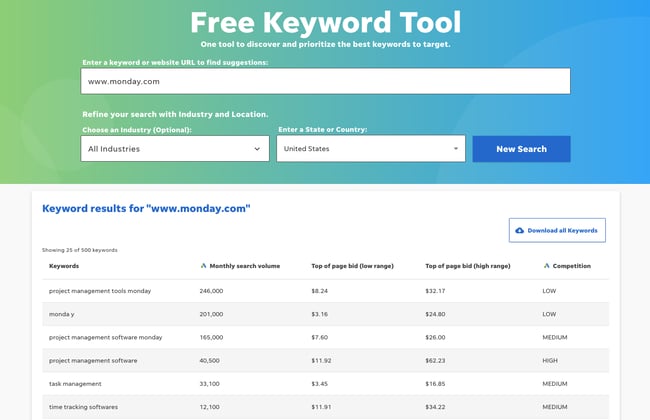
- Head to wordstream.com/keywords.
- Enter your competitor’s website URL in the text bar.
- Click Find My Keywords.
- Confirm the URL, choose an industry (optional), and enter a location.
- Click Continue.
- Click Download all Keywords to send the list to your email.
What WordStream Does Best
WordStream is a simple, easy-to-use tool that gives you an instant list of your competitors’ keywords. Unlike other tools, it’s completely free to use, and you’ll get plenty of information without creating an account. All you need to do is provide your email.
What WordStream Lacks
The tool doesn’t provide your competitors’ actual rankings, which can inform you how well they’re doing for those terms. Because it was created by a marketing agency, not a software company, WordStream is only what you see; it doesn’t offer an upgraded version of its tool with additional features.

Keyword Research Template
Build your SEO strategy with this free template.
-
Search Volume
-
CPC
-
Ranking
-
Keyword Difficulty
2. How to Find Competitors’ Keywords Using Google Keyword Planner
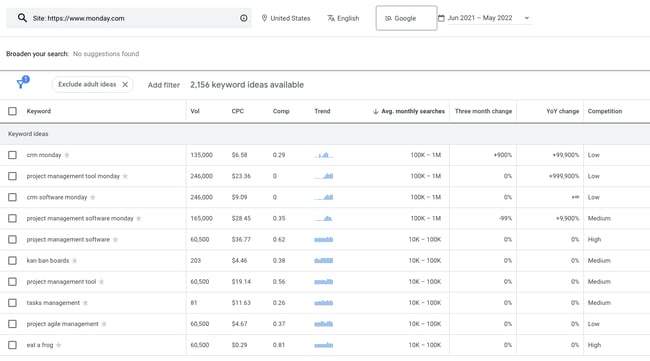
- Head to ads.google.com/home/tools/keyword-planner.
- Click Go to Keyword Planner.
- Log into your Google account if you’re not logged in.
- Choose your Google Ads account from the list, or create a new one by clicking New Google Ads account.
- In your dashboard, tap the box that says Discover new keywords.
- Tap the Start with a website tab.
- Enter your competitor’s URL in the text bar. Choose whether you want to use the entire site or only the home page. Note: We recommend using the entire site at first.
- Click Get results.
What Google Keyword Planner Does Best
Google Keyword Planner is a powerful tool for seeing your competitors’ top keywords with impressive filtering and sorting capabilities. Unlike WordStream, you can filter and sort the keywords in any way you’d like: by average monthly searches, by three-month change, by year-over-year change, by level of competition in the SERPs, and more. In addition, you can choose which columns you’d like to include in your report, then download it as a CSV or Sheets file.
What Google Keyword Planner Lacks
Google Keyword Planner does not offer information on your competitors’ rankings, which won’t tell you where they perform best. Knowing how well they perform is critical for you to compete (and win) in organic search results.
3. How to Find Competitors’ Keywords Using Spyfu
- Head to spyfu.com.
- Enter your competitor’s URL in the text bar.
- Under the header, tap the SEO Keywords tab between Kombat and Ranking History.
What Spyfu Does Best
Spyfu is a fantastic tool for more holistic competitive research, even at its free level. You not only get a list of your competition’s top keywords, but also your competition’s top competitors, inbound links, top pages, and page-one keywords. You can even do a surface-level comparison between your domain and your competitor’s domain.
What Spyfu Lacks
In its free version, Spyfu is a limited competitive keyword research tool, offering only the first 5-10 keywords that your competitor ranks for and gating specific information behind a subscription paywall. The good news is that you can easily snag a subscription starting at $33/month (paid annually), which will help you access all of Spyfu’s features.
4. How to Find Competitors’ Keywords Using Ahrefs Site Explorer
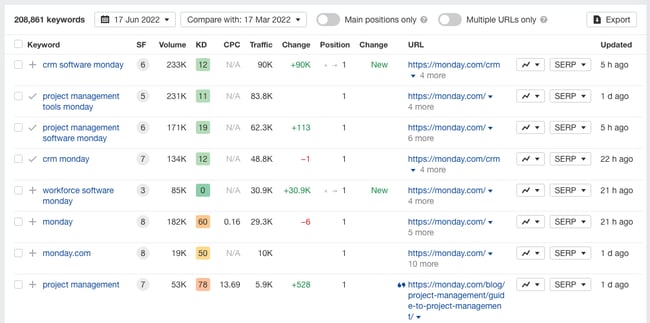
- Head to ahrefs.com/site-explorer.
- Tap Sign up for Ahrefs.
- Choose a subscription level. You will have access to Site Explorer at the Lite plan, which starts at $99/month.
- Inside the dashboard, tap Site Explorer.
- Input your competitor’s URL in the text bar.
- On the sidebar, under Organic search, tap Organic keywords.
What Ahrefs Site Explorer Does Best
As the first fully paid tool on our list, Ahrefs offers all the premium competitive keyword research features you’d expect at a premium price tag. You have full access to your competitor’s full keyword profile and competitor traffic, including ranking gains, ranking losses, and rich snippet wins. The tool also offers impressive filtering capabilities to find or exclude certain keywords, and you can export up to 500,000 rows of keywords for safekeeping.
What Ahrefs Site Explorer Lacks
Ahrefs lacks an introductory competitive research tool that you can use without digging deep into your team’s budget. Some businesses don’t necessarily need position changes or even the entirety of their competitors’ keyword profile. Knowing the basics is sometimes enough to create an initial SEO strategy against competitors.
5. How to Find Competitors’ Keywords Using Semrush
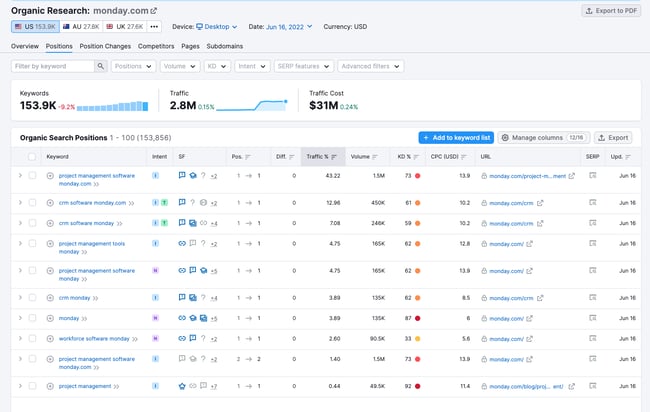
- Head to www.semrush.com/analytics/organic/overview.
- Enter your competitors’ URL in the text bar.
- You’ll be prompted to create a free account. Once you input your email and choose a password, click Create your account.
- You’ll be redirected to a dashboard with all of your competition’s organic performance information.
- In the Top Organic Keywords card, tap View all organic keywords.
- Alternatively, tap the Positions tab next to Overview.
What Semrush Does Best
Semrush is an impressive premium tool that offers you plenty of information for free. You have full access to your competitors’ keyword profile, including position changes, top changes, and top competitors. You can even create a keyword gap analysis between you and your competitors by tapping Keyword Gap on the sidebar, even if you’re not yet subscribed.
What Semrush Lacks
Semrush offers everything you need to carry out a comprehensive competitor keyword analysis for free. However, you’re limited to 10 requests on a free account, so if you expect to analyze more than 10 competitors, expect to upgrade to a paid subscription starting at $119.95/month. The good news is that you can try it for seven days for free. There are tons of more Semrush reviews with more pros and cons of the tool.
6. How to Find Competitors’ Keywords Using SE Ranking
- Head to https://seranking.com/competitor-traffic-research.
- Enter your competitors’ URL in the search bar, pick the location, and click Analyse.
- To proceed, you’ll need to start a 14-day free trial. Then, you’ll be redirected to the platform dashboard with a performance overview of the analyzed site.
- Scroll to the Organic keywords tab and click the View Detailed Report button.
- Alternatively, in the left-side menu, go to Organic Traffic Research — Keywords.
What SE Ranking Does Best
SE Ranking is a solid tool that will give you a 360 view of any competitor’s keyword strategy. You will not only get a complete list of keywords it ranks for but also every keyword’s search volume and difficulty, search intent and SERP features it triggers. You will see how well a competitor ranks for that keyword and how positions changed over the last month. If necessary, you can tap into deeper historical data as well. There are granular filtering options and the list can be further exported.
There is also an option to take your research one step further and analyze how your target keywords overlap with several competitors to find keyword gaps.
What SE Ranking Lacks
SE Ranking has it all, but you’ll need to subscribe to tap into the wealth of data. On the bright side, their pricing model is affordable and starts at $55 per month.
Now that you have your competitors’ keywords, how do you analyze them and put them to action? Let’s take a look.

Keyword Research Template
Build your SEO strategy with this free template.
-
Search Volume
-
CPC
-
Ranking
-
Keyword Difficulty
How To Do Competitor Keyword Analysis
Competitor keyword analysis is similar to but different from standard keyword analysis. Below, we’ll explain the steps that go into the process.
1. Use competitive analysis templates.
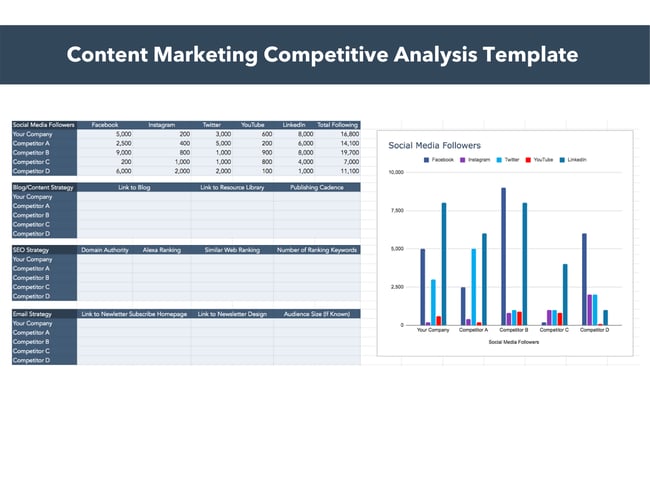
Completing a keyword analysis on your competitors can be a time-consuming process, and keeping all the information you find in one place can be a challenge. For that reason, we recommend using a competitive analysis template to organize your efforts and keep your findings in one place.
In this template, you’ll get:
- Two-Feature Competitive Landscape Chart
- Competitor Strategic Overview
- Content Marketing Analysis Template
- You vs. Competitor Side-By-Side
- Competitor Battle Card
- Multiple Competitor Feature Comparison
- Multiple Competitors Scoring Card
- SWOT Analysis Template
- Categorical Feature Comparison Template
- Review Tracker
What you’ll find most useful is the Content Marketing Analysis Template, where you can list multiple competitors and the number of keywords each one ranks for.
2. Create a list of your top SERP competitors.
After you download your template, it’s time to create a list of your top competitors. You can add a tab on your competitive analysis template and simply add one competitor per row. Knowing who your main competition is makes it easier for you to create a more targeted and effective SEO strategy.
Keep in mind that your product competitors may not be the same as your SERP competitors. It’s likely that many businesses out there offer the same products and services that you do, but they may not all be viable SERP competitors. You should only include the competitors that consistently rank for the same keywords you’re trying to rank for.
You can find out who that is by using Spyfu. Here’s how:
- Head to spyfu.com.
- Input your own URL in the text bar.
- Click the Competition tab to see your organic competitors.
These are the brands that compete the most with you on the SERPs.

3. Find your competitors’ keywords.
Once you’ve identified your top competitors, find the keywords that they rank for and outrank you for, and understand how difficult it would be for you to outshine them. Add a separate tab for each competitor in your competitive analysis template.
We’ve already discussed how you can find those keywords. To summarize, we recommend the following tools:
- WordStream: Good option that will give you a general idea of your competitors’ keyword profile.
- Google Keyword Planner: Great option that will give you a general idea of your competitors’ keyword profile, with filtering and sorting options.
- Spyfu: Strong option that will give you a more holistic overview of your competitors’ organic performance, but you’ll need to pay $33/month to access the full keyword profile.
- Ahrefs Site Explorer: Strong premium option that will give you access to your competitors’ full keyword profiles and rankings. This tool is available at a fee of $99/month.
- Semrush: Excellent premium option that gives you full access to your competitors’ keyword profiles, rankings, organic performance metrics, and keyword gaps, but free requests are limited. If you’d like to make more requests, you’ll need to upgrade to a subscription, starting at $119.95/month.
- SE Ranking: Powerful option that provides a full-scale overview of your competitors’ keywords with every relevant metric you need to effectively analyze keyword data. The monthly subscription fee starts at $55/month.
4. Identify keyword gaps and content gaps.
Once you have your competitors’ keywords, the fun part begins: Actually vying for a better spot on those keywords’ SERPs and beating your competition.
First up, you need to identify which keywords your competitor ranks for that you don’t rank for, and which of their pages are ranking for those terms. You can go by gut feeling — for instance, you may know already that you don’t rank for X term — or you can use a tool. We recommend the latter option.
Spyfu, Ahref, and Semrush all offer this information.
To find keyword gaps in Spyfu:
- Head to spyfu.com.
- Input your own URL in the text bar.
- Click the Kombat tab.
- Spyfu may have already pre-chosen competitors for you. If you want to add or replace a domain, you can do so in the Kombat tool’s text bar.
- Click the Missing Keywords box on the right-hand corner.
There, you’ll see an initial list of the keywords your competitors rank for that you don’t rank for. You’ll be able to filter, too, but to see the full list, you’ll need to upgrade.
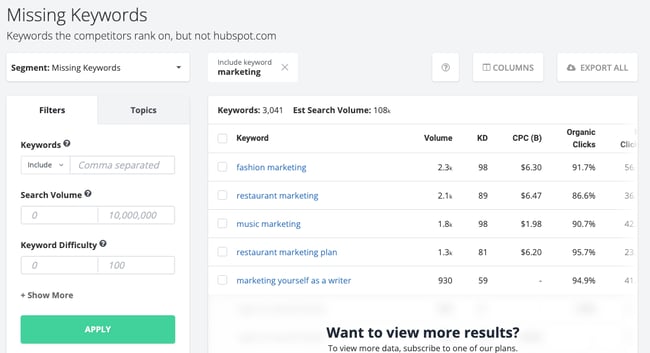
To find keyword gaps in Ahrefs:
- Head to ahrefs.com.
- Sign into your Ahrefs account. You’ll need a premium subscription.
- On the top nav bar, tap Site Explorer.
- Input your own URL in the text bar.
- On the sidebar, tap Content gap under Organic search.
- Input your competitor’s URL in the text bar. You can insert up to 3 competitors.
- Click Show keywords.
 You’ll see the keywords that your competitor ranks for, as well as their highest positions for those terms.
You’ll see the keywords that your competitor ranks for, as well as their highest positions for those terms.
To find keyword gaps in Semrush:
- Head to semrush.com.
- Sign into your Semrush account. If you’ve already made 10 requests in one day, you’ll need to upgrade to a free trial of the tool or a paid subscription.
- On the sidebar, tap Keyword Gap under Competitive Research.
- Input your own URL in the first text bar.
- Input your competitor’s URL in the next text bar. You can insert up to 4 competitors.
- Click Compare.
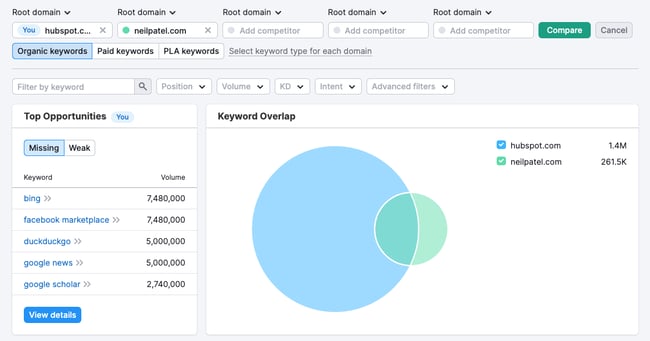
If you want to see all missing or weak keywords, you’ll have to upgrade to a paid account.
To find keyword gaps in SE Ranking:
- Head to seranking.com.
- Sign into your account. You’ll need a paid subscription.
- Go to Competitive Research, enter your own site URL, and pick the location.
- In the left sidebar, navigate to Competitor comparison.
- Input your competitor’s URLs and click Show results.
- Click Compare.
5. Understand your and your competitors’ audience.
One of the most important factors of competitive keyword research is to understand your audience and what they’re interested in. You also need to understand your competitors’ audience. Ideally, these would be one and the same, but there may be some instances where you may want to capture your competitors’ audience because of good product-fit.
During this stage, create well-rounded buyer personas that explain your audience members at all levels of the buyer’s journey, from the awareness to the post-decision stage. This information will help you come up with a wide range of keywords that relate to your business and additional opportunities to outrank your competitors with well-targeted content.
For example, if you’re running a software company, you should optimize your site to attract users who are browsing for different software options, but also for those that have purchased your products and want to understand how to further engage with it.

Keyword Research Template
Build your SEO strategy with this free template.
-
Search Volume
-
CPC
-
Ranking
-
Keyword Difficulty
6. Create audience-centric and SEO-optimized content to fill content gaps.
You have your competitors, their keywords, and the keywords they rank for that you don’t rank for. You also have an understanding of your audience. It’s time to create content that will help you outrank your competition.
This content may include:
You should create a strong SEO strategy and content plan to organize your content creation efforts and get ahead of your competitors. Source ideas from their website and blog and document these potential projects in your competitive analysis sheet.
Since creating content can be overwhelming at first, you should leverage special tools to speed up the learning and creation process, such as:
- An editorial calendar
- A content marketing workbook
- A content marketing planning template
- An SEO starter kit
- An on-page SEO template
7. Track your competition’s performance.
Track your competitors’ monthly search volume, backlinks, domain authority, and factor all of this information into your plan. If you realize that it will be extremely difficult to outrank for certain keywords, it’s still worth considering making content for them, as you’ll be providing your audience with the information they’re looking for.
All in all, these strategies will help you stay focused and ensure that you outperform your competitors for business development and lead generation.
Competitor Keyword Analysis Tool
During the analysis process, you can opt to use a wide variety of tools to keep track of your competitors’ performance. The best part? Most of these are free.
1. Google Alerts

Google Alerts is a simple, free tool that you can use to monitor the web and keep an eye out for content related to you, your competition, and your shared (or not shared) keywords. You can set it up to receive email alerts whenever a keyword you target is mentioned online, and you can even track mentions of your competitors to understand where they get backlinks from.
Pricing: Free
2. Social Mention
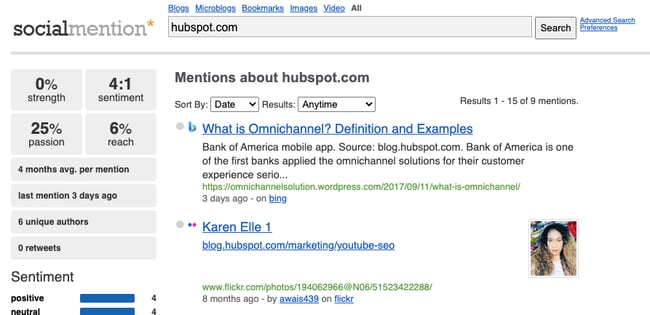
Social Mention, as the name suggests, monitors social platforms and compiles reports of all the platforms where your keywords are mentioned. Simply type a keyword into the search bar, and you’ll get instant analytics on the number of mentions, users, sentiments of those mentions (positive, negative, or neutral), as well as previews of the mentions that people have made.
Pricing: Free
3. Moz’s Link Explorer
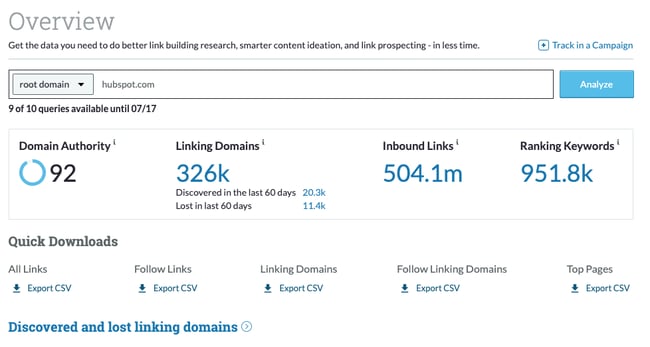
Moz’s Link Explorer functions as a search engine for links, backlinks, and mentions. You can use it to research your competitors’ linking strategy and see how they’re building their web presence. If one of your competitors has a particularly high search ranking, you’ll be able to see exactly how they got there.
The tool requires signup and comes with 10 link queries and 50 rows of data per query every month. If you want more powerful capabilities, you can upgrade to a paid subscription.
Pricing: Free; $99/month (Standard); $179/month (Medium); $299/month (Large); $599/month (Premium)
4. Semrush
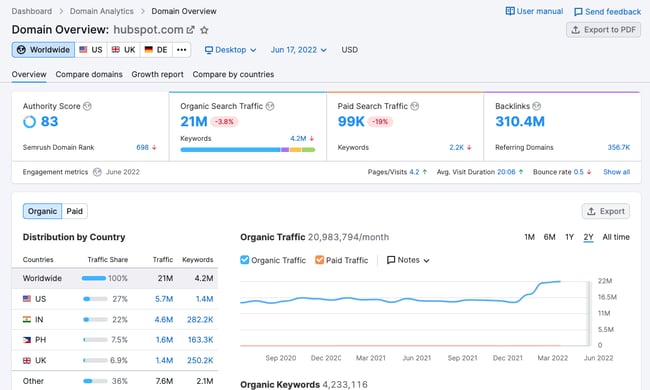
Semrush offers powerful tools for analyzing keywords, traffic, rankings, and URLs. You’ll get an overview of on-page SEO standing for the links you enter, analyze a domain’s backlink profile, and track your own SERP positions. You’re required to create an account, and there are both free and premium options.
Pricing: Free (10 requests/day); $199.95/month (Pro); $229.95/month (Guru); $449.95/month (Business)
5. Ahrefs
Ahrefs is an all-in-one tool for competitive analysis. You’ll need to make an account, but you have the ability to analyze your competitor’s backlinks and referring domains, organic traffic, and the number of organic keywords they rank for. You can also use the tool to study what your customers are searching for and to conduct general keyword research.
Pricing: $99/month (Lite); $199/month (Standard); $399/month (Advanced); $999/month (Enterprise)
6. SE Ranking
SE Ranking is an all-in-one SEO tool for all-around competitive research. With a paid subscription, you will be able to check your competitor’s organic traffic and keywords they rank for, evaluate their backlink profiles, and assess their technical health by running a comprehensive audit. When you use SE Ranking to optimize the on-page parameters of your pages or create new content from scratch, it will give recommendations based on the parameters of your top-ranking competitors.
Pricing: $55/month (Essential); $109/month (Pro); $239/month (Business).
Use competitor keyword analysis to guide your content decisions.
Similar to keyword research, competitor keyword analysis helps you be more focused during the content content creation process. You’ll know which keywords your audience is looking for, which competitors are creating keywords for that content, and how hard it will be to outrank your competitors when you create competitive content.
Once you’ve completed your competitor analysis, you’ll be able to create a content strategy that will help you build your authority and dominate the SERPs.
Editor's note: This post was originally published in March 2020 and has been updated for comprehensiveness.
![Download Now: Keyword Research Template [Free Resource]](https://no-cache.hubspot.com/cta/default/53/447dd5f8-1426-4fb6-af75-b6e55bb759a2.png)
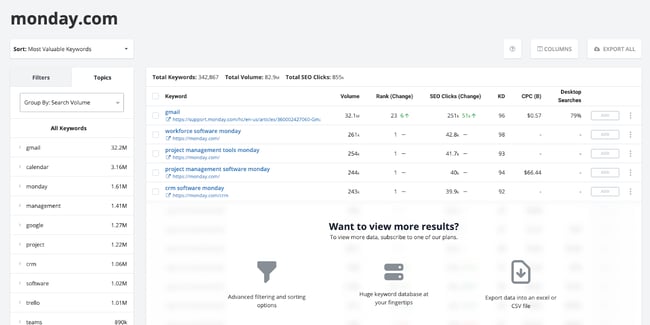

![10 Best Tools to Check Website Traffic [+ What They’re Best For]](https://blog.hubspot.com/hubfs/GettyImages-1332148900%20copy.jpg)



![Why You Should Want Visitors to Click Through Multiple Screens [Data + Tips]](https://blog.hubspot.com/hubfs/GettyImages-1256724253.jpg)



